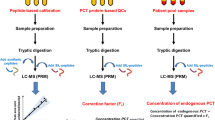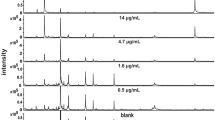Abstract
The development of selective and sensitive biological recognition elements, e.g., antibodies, for the detection of relevant blood markers is a great challenge in the field of biosensors. In this context, five new rat monoclonal antibodies (mAbs) for procalcitonin (PCT), a marker for bacterial infection and sepsis, were developed and characterized. One mAb, PROC1 3G3, was used as capture antibody. Four mAbs, PROC4 6C6, PROC4 6B2, PROC4 1G3, and PROC4 1D6, were used as detection mAbs, either as Protein G-purified or as biotinylated mAbs. A surface plasmon resonance (SPR) biosensor was used to characterize the antigen–antibody biomolecular interactions. The capture mAb (PROC1 3G3) has an equilibrium dissociation constant (K D) of 3.42 × 10–8 M. All four detection mAbs (PROC4 6C6, PROC4 6B2, PROC4 1G3, and PROC4 1D6) are of high affinity (K A = 2.81–6.11 × 108 M−1; K D = 1.64–3.56 × 10–9 M) and have moderate dissociation rate constants (k d = 1.70–2.40 × 10–3 s−1). Four different sandwich enzyme-linked immunosorbent assays (ELISAs) with standards of human recombinant (hr) PCT, using PROC1 3G3 as capture mAb and PROC4 mAbs as detection mAbs, respectively, led to highly specific determinations of PCT without cross-reactivities to calcitonin and katacalcin. The lower limits of quantification (LLOQ) for hrPCT (in 40 mM phosphate-buffered saline (PBS), pH 7.6) with these assays ranged from 2.3 to 12.8 µg L−1. In addition, sandwich ELISAs were set up with biotinylated PROC4 mAbs, and with hrPCT in 4% human serum albumin (diluted 1:10 in 40 mM PBS, including 1:5 (v/v) LowCross Buffer®). The LLOQs of these sandwich assays ranged from 4.1 to 6.0 µg L−1 and were thus much closer together for the different assays. With the latter assay setup (PROC1 3G3 as capture mAb, PROC4 6C6–biotin as detection mAb) a first collection of five serum samples was determined (healthy volunteers, unspiked, and spiked). Recovery rates for the spiked samples ranged from 98.3 to 115.7%. The newly developed anti-PCT mAbs should find broad applications in immunosensors for point-of-care diagnostics of sepsis and systemic inflammation processes.





Similar content being viewed by others
Abbreviations
- BSA:
-
bovine serum albumin
- D:
-
dalton
- EDC:
-
1-ethyl-3-(3-dimethylaminopropyl)carbodiimide
- ELISA:
-
enzyme-linked immunosorbent assay
- HBS:
-
HEPES-buffered solution
- HRP:
-
horseradish peroxidase
- HSA:
-
human serum albumin
- IgG:
-
immunoglobulin G
- IC50 :
-
inhibitory concentration 50%, test midpoint of the standard curve
- K A :
-
association constant
- K D :
-
dissociation constant
- KLH:
-
keyhole limpet hemocyanin
- LLOQ:
-
lower limit of quantification
- LOD:
-
limit of detection
- mAb:
-
monoclonal antibody
- NHS:
-
N-hydroxysuccinimide
- OVA:
-
ovalbumin
- PBS:
-
phosphate-buffered saline
- PBST:
-
phosphate-buffered saline with Tween 20
- PCT:
-
procalcitonin
- POCT:
-
point-of-care testing
- RU:
-
resonance units
- SPR:
-
surface plasmon resonance
- TMB:
-
3,3′,5,5′-tetramethylbenzidine
References
Schneider HG, Lam QT (2007) Pathology 39:383–390
Moya F, Nieto A, R-Candela JL (1975) Eur J Biochem 55:407–413
Le Moullec JM, Jullienne A, Chenais J, Lasmoles F, Guilana JM, Milhaud G, Moukhtar MS (1984) FEBS 167:93–97
Meisner M, Tschaikowsky K, Schnabel S, Schmidt J, Katalinic A, Schuttler J (1997) Eur J Clin Chem Clin Biochem 35:597–601
Nijsten MW, Olinga P, The TH, de Vries EG, Koops HS, Groothuis GM, Limburg PC, ten Duis HJ, Moshage H, Hoekstra HJ, Bijzet J, Zwaveling JH (2000) Crit Care Med 28:458–461
Oberhoffer M, Stonans I, Russwurm S, Stonane E, Vogelsang H, Junker U, Jaeger L, Reinhart K (1999) J Lab Clin Med 134:49–55
Ghillani P, Motte P, Bohuon C, Bellet D (1988) J Immunol 141:3156–3163
Althaus H, Walter, G (2002) US 6,451,311 B2
BRAHMS Aktiengesellschaft (2008) http://www.procalcitonin.com. Accessed 25 July 2008
Morgenthaler NG, Struck J, Fischer-Schulz C, Bergmann A (2002) Clin Chem 48:788–790
Köszegi T (2002) J Biochem Biophys Methods 53:157–164
Hubl W, Kraßler J, Zingler C, Pertschy A, Hentschel J, Gerhards-Reich C, Mack M, Demant T (2003) Clin Lab 49:319–327
Yamada H, Matsuda S, Ushio Y, Nakamura K, Kobatake S, Satomura S, Matsuura S (2008) Clin Chim Acta 388:38–40
Balog A, Ocsovszki I, Mándi Y (2002) Immunol Lett 84:199–203
Köhler G, Milstein C (1975) Nature 256:495–497
Whitaker JR, Granum PE (1980) Anal Biochem 109:156–159
Biacore, 2003, Sensor Surface Handbook, Uppsala, Sweden
Brent R (2006) Curr Protoc Mol Biol 20:0.1–0.6
Inczendy J, Lengyel T, Ure AM (1998) Compendium of analytical nomenclature: the orange book, 3rd edn. Blackwell Science, Oxford, ISBN 0–632–05127–2
Kemmler, M, Koger B, Sulz G, Sauer U, Schleicher E, Preininger C, Brandenburg A (2008) Sensor Actuat B Chem (submitted)
Acknowledgements
The authors thank Dr. Gabriele Moeller, Institute of Experimental Genetics, Helmholtz Center Munich, for her scientific introduction to SPR. We acknowledge Mr. Werner Doll (Medical University of Graz, Dept. for Internal Medicine, Diabetes and Metabolism, Graz, Austria) for the provision of patient (healthy volunteers) serum samples. This work was supported by the European Commission under the Sixth Framework Program within the integrated research project CARE-MAN (HealthCARE by Biosensor Measurements And Networking (NMP4-CT-2006–017333)).
Author information
Authors and Affiliations
Corresponding author
Rights and permissions
About this article
Cite this article
Krämer, P.M., Gouzy, MF., Keß, M. et al. Development and characterization of new rat monoclonal antibodies for procalcitonin. Anal Bioanal Chem 392, 727–736 (2008). https://doi.org/10.1007/s00216-008-2321-4
Received:
Revised:
Accepted:
Published:
Issue Date:
DOI: https://doi.org/10.1007/s00216-008-2321-4




